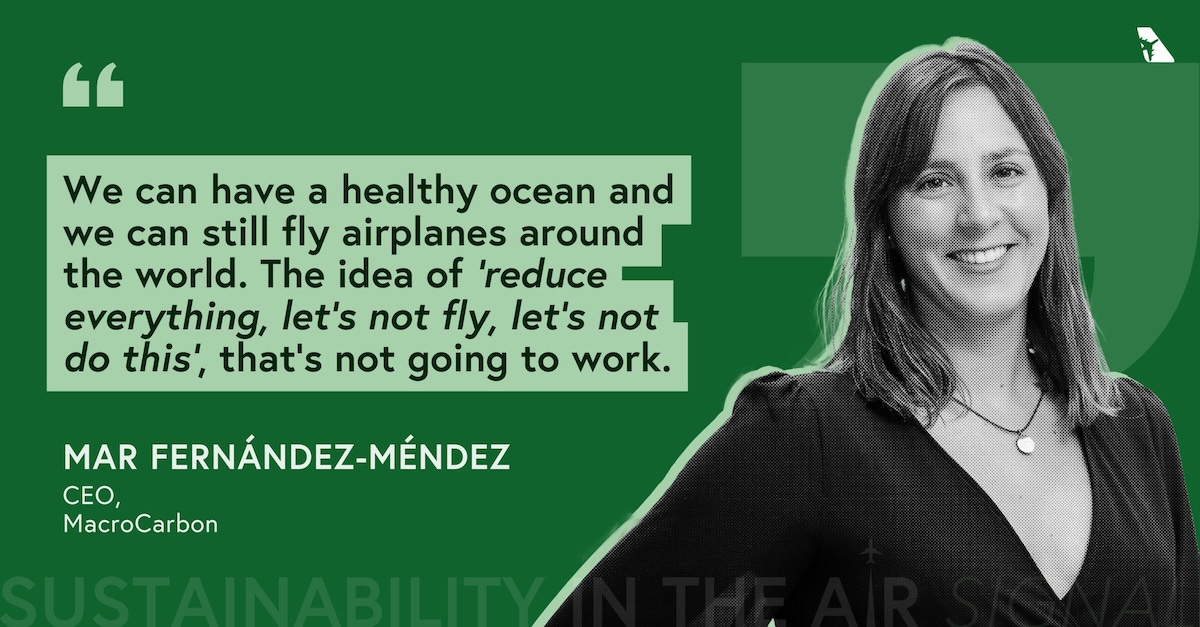Climate commentator Quico Toro has made a bold prediction: by the mid-2030s, the world could see its first sargassum billionaire. The candidate? Dr Mar Fernández-Méndez, co-founder of the Canary Islands-based startup MacroCarbon.
We interviewed Dr Fernández-Méndez in the latest episode of the Signal, Sustainability in the Air podcast, and started by asking her about the billionaire prediction.
“We all wish for that, right? But with how the world works right now, I’m not sure if pushing sustainability and new sources of energy will become the next billionaire business.” Still, she adds, “I will definitely become one of the experts in sargassum and how to cultivate it in the ocean.”
But what exactly is Sargassum, and why does Toro believe it holds such promise?
Sargassum is a type of brown macroalgae that spends its entire life floating in the ocean, capturing carbon dioxide at extraordinary rates. Nothing that lives, Toro notes, captures carbon faster than this seaweed, which is so prolific it gave its name to an entire sea. And because our planet is 70% ocean, the potential area for growth — and carbon capture — is enormous.
Here are the key highlights of the conversation:
What is sargassum and why it’s special (3:40)
The Caribbean sargassum crisis and global opportunity (8:24)
How MacroCarbon differs from microalgae biofuel approaches (12:33)
Cost comparison: MacroCarbon SAF vs. existing pathways (18:53)
Commercial scale and farm requirements (21:32)
Unlimited scalability potential (30:25)
The three valleys of death in climate tech (35:46)
BlueSAF Plus: Carbon-negative biofuels with biodiversity benefits (37:05)
Keep reading for a detailed overview of the episode.
A crisis becoming catastrophic
It’s also becoming an increasing environmental and economic problem. For anyone living along the Caribbean coast, Gulf of Mexico, or Florida’s shores, sargassum has become an annual plague.
Since 2011, blooms have exploded, forming the “Great Atlantic Sargassum Belt“, a massive floating ecosystem stretching from West Africa to the Caribbean. Millions of tonnes wash ashore each year, driven by rising ocean temperatures, changing wind patterns, and nutrient runoff.
When sargassum decomposes on beaches, it releases methane — a greenhouse gas 28 times more potent than CO2. Dense mats block sunlight underwater, smothering coral reefs and creating dead zones. For tourism-dependent Caribbean economies, losses from cleanup efforts and fishing industry damage exceed $300 million annually.
Yet this is what makes Fernández-Méndez’s vision compelling: transforming pollution into valuable products.
From Arctic ice to floating seaweed
Fernández-Méndez began studying Arctic ice, drawn by questions about sequestering CO2 in the ocean.
“I would go every year to the Arctic, and even from year to year, you could see how it was rapidly declining,” she explains. But she realised the Arctic Ocean wasn’t the solution. “The productivity, the amount of carbon that is sequestered there, is relatively small compared to other areas.”
That journey took her to Sargassum. “It’s very efficient at carbon sequestration. With very few nutrients, it can sequester a lot of carbon. It can double its biomass in 10, 20, 30 days. That’s pretty fast compared to other plants and algae.”
Turning problem into product
MacroCarbon’s approach begins with a simple advantage: the feedstock grows wild in the open ocean, requiring no cultivation infrastructure, freshwater, fertiliser, or land. The company intercepts it before it reaches shore.
This creates an unusual economic advantage: MacroCarbon could solve a problem while securing free feedstock.
Its proposed thermal biorefinery process extracts multiple products:
A screw press produces bio-stimulants for agriculture;
Pyrolysis creates biochar that permanently sequesters carbon;
Electric methane pyrolysis separates carbon from hydrogen, producing carbon black while liberating hydrogen for fuel production.
“Other processes to produce sustainable aviation fuel require an external source of green hydrogen,” Fernández-Méndez explains. “We don’t need that. We create our hydrogen ourselves.”
The technology is species-agnostic, working with any brown or green seaweed.
The economics and vision
An initial facility with six square kilometres of aqua farms feeding a six-lane processing plant could produce 8,000 tonnes of SAF annually, roughly 400 round-trip flights from the Canary Islands to mainland Spain.
At scale, MacroCarbon projects SAF production at $1,500 per tonne, below current market prices of $2000-$2,500 per tonne (higher for PtL). Factor in airline carbon credits under the EU’s ETS system, and the economics become even more favourable.
In October 2025, MacroCarbon received permits from the Canary Islands government for a 40,000 m² seaweed farm near the Plataforma Oceánica de Canarias, a significant scale-up that bridges the gap between pilot and commercial deployment.
The first full commercial facility, requiring €80 million, could be operational within a few years.
“The thing that has been most surprising for me was that in the startup world you really need to have a good story,” Fernández-Méndez reflects. “You can have a lot of data, but if you don’t tell it the right way at the right moment, you won’t succeed.” Her own story centres on BlueSAF Plus — “blue” because it comes from the ocean, and “plus” because it’s carbon-negative and helps restore marine biodiversity.
The road ahead
By 2035, Fernández-Méndez envisions “maybe two of these first-of-a-kind facilities. Maybe one in the Canaries, one in the Azores, one in Cape Verde. And then we are expanding to Asia, to the Caribbean.”
On scale potential: “I don’t think there’s a limit. The limit is the ocean and how much funding we can raise. You can get to a gigaton scale in terms of CO2 in 10 years.”
Will she become a sargassum billionaire? That may be the wrong question. The more relevant question is whether MacroCarbon can prove that turning environmental crises into economic opportunities is a viable model for deeptech climate solutions.
If Fernández-Méndez succeeds, the real wealth will be measured in millions of tonnes of CO2 prevented from entering the atmosphere, in clean beaches, in thriving fishing industries, and in proof that we can build profitable businesses by solving problems.
That would make her not just a sargassum billionaire, but a pioneer who showed us how to turn the rising tide into opportunity.












